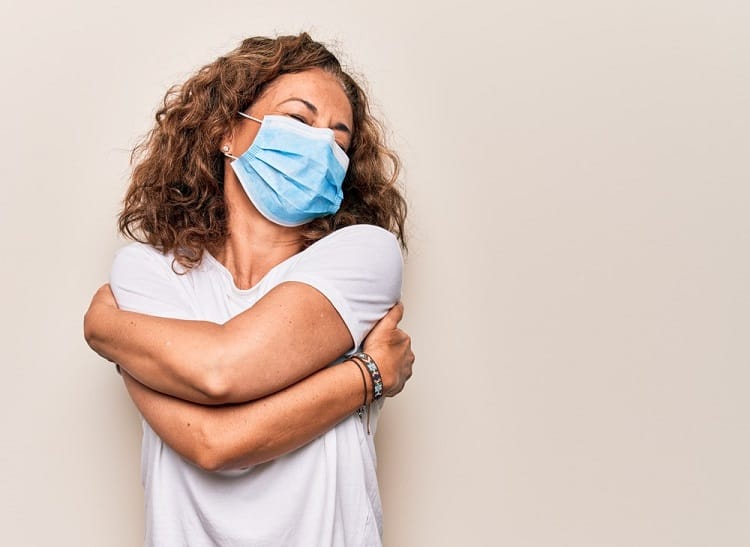Being responsible for teaching and supervising a classroom full of kids is stressful even during normal times. Throw a global pandemic into the mix, and you may find yourself questioning why you ever decided to become a teacher in the first place. While some schools are still teaching students remotely, many districts have moved to full in-person instruction or hybrid models in which students attend class in person on some days and via the internet on others.

Source: Golubovy/Shutterstock.com
If the administration of your school district is forcing in-person learning, it’s normal to feel apprehensive. While children typically do not suffer severe consequences if infected with COVID-19, older people are much more likely to become severely ill.
Whether you are concerned about getting sick yourself or potentially bringing the virus home to your loved ones, though, there are things you can do to protect yourself and put your mind at ease. From laundering your work clothes using antimicrobial laundry detergent to making time for self-care, here are a few tips to ease your anxieties as a teacher.
Rethink Your Work Attir3e
Many school districts have relaxed their dress codes and are encouraging educators to wear scrubs to work instead of their usual business casual attire. There are several reasons why teachers and professors should wear scrubs in the classroom during this time. The bottom line, though, is that they are easy to clean and disinfect. They also commonly have antimicrobial properties that make them less hospital for viruses, bacteria and germs to live on.
Because they are worn by doctors, nurses and other healthcare providers in medical settings, scrubs are designed to hold up to frequent washing in hot water. When you wash scrubs using antimicrobial laundry detergent, you can rest assured that they will emerge fully clean, sanitary and ready to wear.
Scrubs come in a wide range of colors and styles. While they aren’t the type of workwear most people think of for teachers, they do have a professional appearance. Wearing printed scrub tops in the classroom is even a way to spread a bit of cheer to younger students during these difficult times.
Wearing scrubs and using antimicrobial detergent can help put your mind at ease and make you feel safer. Changing your clothes as soon as you get home from work will help calm your anxiety about bringing the virus home to your family, too.
Always Be Prepared

Source: Dragon Images/Shutterstock.com
“Always be prepared” is an unofficial motto that is shared by many teachers. Planning ahead allows you to run your classroom efficiently and diminishes the risk of running into unexpected problems throughout the day. In the case of teaching during COVID-19, it can help put your mind at ease and soothe your anxiety about returning to the classroom.
Familiarize yourself with your district’s policies regarding COVID-19. Make sure you know the regulations inside and out, and don’t be afraid to reach out to the administration if you have any questions or concerns. Pay close attention to things like how you’ll need to set up your classroom, whether students are required to wear masks, if you’ll be expected to teach different students on different days and other concerns.
Be sure to keep a close eye out for policy updates, too! As the COVID situation evolves, be prepared for changes throughout the school year.
Come up with a plan for how you will handle various situations — even if there is not an “official” policy in place. Determine how you’ll ensure that your students abide by current regulations and restrictions, what you’ll do if a problem arises and what steps you will personally take to protect your students, yourself and the community.
Planning ahead eliminates many of the “unknowns” that contribute to anxiety. The more you can figure out before you head back into the classroom, the better you’ll feel.
Take Care of Yourself

Source: Krakenimages.com/Shutterstock.com
Teaching is stressful during the best of times, and burn-out is a common problem. With the added stress of a pandemic on your shoulders, feeling anxious is to be expected. While it’s always important to practice self-care, now is definitely not the time to neglect your well-being.
Pay attention to how you are feeling. If you become aware of warning signs like rapid heartbeat, overthinking, trouble concentrating, sleep changes, stomach problems, avoidance or memory issues, take a step back to evaluate the situation. Consider what’s causing these feelings, and try to work through them. Write your feelings down in a journal or talk to a friend or loved one. If these things don’t work, consider speaking with a mental health professional or taking advantage of other mental health resources for educators. Your anxiety is real, and there is no need to suffer in silence.
Even if you aren’t feeling completely overwhelmed by anxiety, now is an excellent time to practice self-care. Make time for a bubble bath in the evening, schedule a massage on the weekend, work on art or craft projects or go for a walk. Even spending an evening cuddling with your favorite pet is an act of self-care that can help you overcome anxiety.
Conclusion
As a teacher, it is normal if you are feeling anxiety that goes beyond the normal “first-day jitters” at the thought of returning to the classroom. The prevalence and factors for anxiety during the coronavirus disease 2019 (COVID-19) epidemic among teachers are well-documented and prove that you certainly are not alone if you are struggling during this challenging time.
If you are feeling anxious about returning to in-person instruction, the tips listed above may help put your mind at ease. It’s also a good idea to talk to the administration of your school district and/or the school nurse to express your concerns and get their input. Even talking to your fellow educators could help you uncover helpful coping strategies for managing your anxiety. No matter what, remember that you are not alone and that there are resources available to help you during this difficult time.

